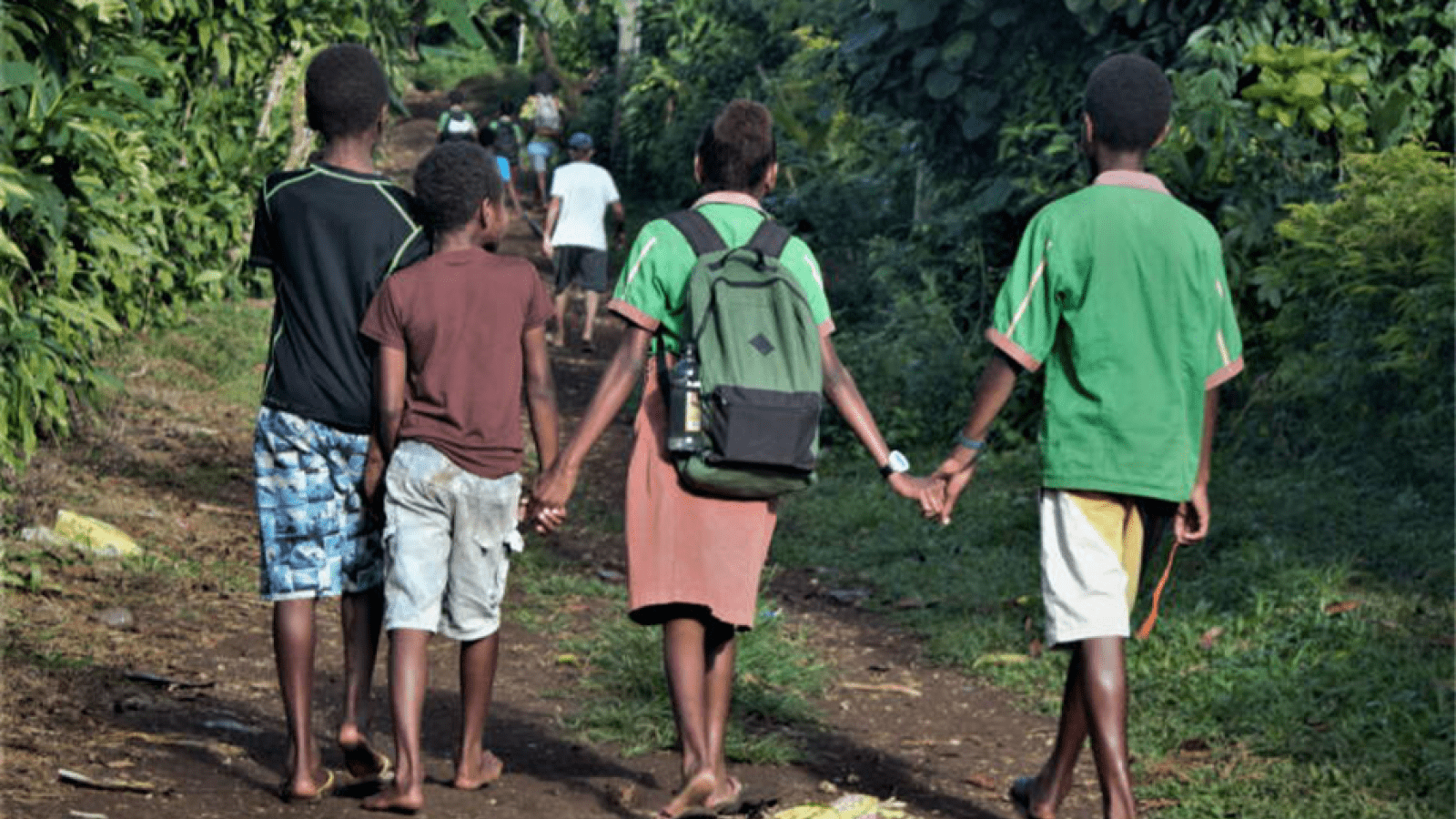How storytelling through photos is challenging Australia’s migration narrative

Four children holding hands while walking to school in a Vanuatu village. Photo: Frank.
In a photo taken by Frank, a young man from Vanuatu, four children walk hand in hand down a country road on their way to school in a village near Port Vila—some of them barefoot, some without school uniforms, and only one carrying a school bag.
Frank said the father of the four schoolkids had gone overseas as a temporary migrant worker but later ‘absconded’.
“His wife works but it’s really difficult for her to provide everything because her husband left and the money that he sends is just limited. So the children have become victims, and so has their education”, he explained.
“Children are often the reason people migrate for work—yet, sometimes, they also bear the brunt of unjust migration systems,” says Dr Matt Withers, the organiser of the photography workshop that Frank participated in.
“This photo captures some of the lesser-told experiences of the families of overseas Pacific workers.”
A sociologist from The Australian National University (ANU), Withers is now exhibiting the photographs he collected in Vanuatu as part of his research project Together, Apart. The project seeks to unveil the untold experiences and predicaments of Pacific migrant workers and their families under Australia and New Zealand’s guestworker schemes.
The hidden costs of migration
Australia’s primary long-term guestworker migration scheme, the Pacific Australia Labour Mobility (PALM) scheme, was implemented in 2022.
The PALM scheme allows workers from nine Pacific Island Countries and Timor-Leste to perform low-wage work in rural areas in Australia for up to four years, tied to their employers.
While the Australian Government has praised the scheme as a development initiative for guestworkers and their home countries, less attention has been given to its potential adverse social and economic outcomes, such as exploitative working conditions and forced family separation.
To address this gap, Withers integrates personal relations and unpaid labour into the evaluation of development outcomes.
“My research shows that economic gains are often accompanied by steep personal and social costs that can actively undermine sustainable development outcomes,” he says.
“The displacement of unpaid labour previously performed by migrant workers can be significant in the South Pacific countries where subsistence agriculture remains a key part of the economy, natural disasters require labour-intensive recovery efforts, and care practices are at the centre of family and community life.”
Funded by the ANU Future Scheme, his research looks into the challenging realities facing PALM workers and their families living “together, apart”, as prolonged separation can place considerable strain on personal relationships and care practices that sustain everyday lives.
His findings have appeared in several academic journals, government reports and think tank publications, and have influenced policy change to better support PALM workers and their families. One such change is the adoption of improved pre-departure briefings to help workers and their families prepare for upcoming separation periods.
While this marks an important step forward, Withers cautions that the measures remain insufficient. He continues to advocate for fundamental work rights for migrant workers, such as the freedom to change employers, to be accompanied by their family members, and to access social protection in Australia.
Now, entering the later stages of his research, Withers is compiling his data and findings into a book to offer an authoritative account of the past, present and possible futures of Australia’s guestworker policies.
Giving voice to the unseen
One notable part of Withers’s research is a participatory photography project he and his colleagues carried out in Vanuatu.
Using a method known as “photovoice”, which involves participants commenting on the meaning of photos they have taken, they were able to capture the lived experiences of young people from migrant households whose voices are generally unheard.
Collaborating with the Vanuatu Government and the youth centre “Wan Smolbag” in Port Vila, which offers skills and arts classes and development support for local young people, Withers and his colleagues recruited 12 local youth volunteers who were all members of families with relatives working overseas as guestworkers.
They attended a crash course in photography techniques and received digital cameras to document what migration had meant for their families and communities.
And the outcome surprised Withers and his team.
“When we first saw the photos, some of them seemed very obscure, with little reference to migration. But once the photographers explained the meaning in the photos, we realised that the images spoke directly to the ambivalence of migration outcomes: the material benefits and ‘success stories’ of some, the frustrations and hardships endured by others, and many instances where these experiences coincided.
“Morality emerged as an unexpectedly prominent theme, with many of the images reflecting on the obligations of migrant workers to remember their families and stick to their goals, like the story Frank shared with us.”
To further amplify the voices of PALM workers and their families, Withers has combined his findings with two other participatory photography research projects on migrant workers to host a collective photography exhibition at ANU, Temporary: We Wanted Workers But We Got People Instead last March.
“We took this as an opportunity to showcase the experiences of PALM workers and their families to a range of academics, policymakers and civil society actors who are rarely exposed to the human side of the scheme.”
Temporary: We Wanted Workers But We Got People Instead was exhibited from 12 March until 26 April 2025. The exhibition’s catalogue can be viewed here.
Further details on the exhibition are available on the ANU School of Sociology websiteand the Together, Apart website.
This article was originally published on Research and Innovation news, here.